Click on images to enlarge
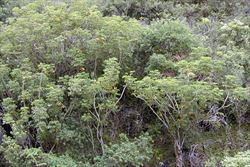
infestation (Photo: Forest and Kim Starr, USGS)
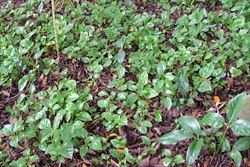
infestation of seedlings (Photo: Sheldon Navie)
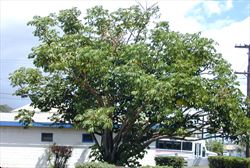
many-stemmed habit (Photo: Forest and Kim Starr, USGS)
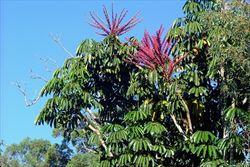
habit in flower (Photo: Sheldon Navie)
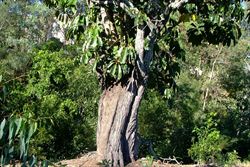
habit growing on another tree (Photo: Sheldon Navie)
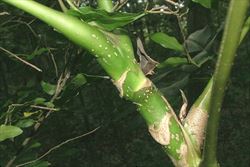
greenish younger stem showing leaf scars and whitish spots (Photo: Sheldon Navie)
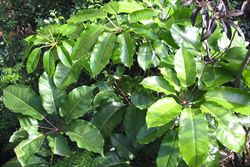
large compound leaves with several leaflets (Photo: Sheldon Navie)
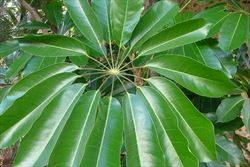
compound leaf with radiating leaflets (Photo: Sheldon Navie)
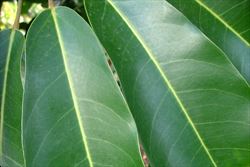
close-up of glossy green leaflets (Photo: Sheldon Navie)
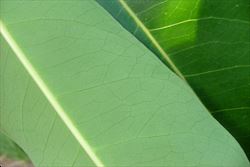
close-up of paler leaflet underside (Photo: Sheldon Navie)
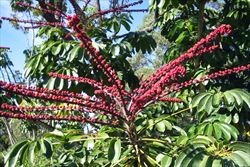
massive branched flower cluster (Photo: Sheldon Navie)
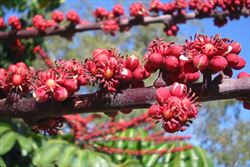
close-up of the bright red flowers (Photo: Sheldon Navie)
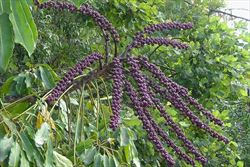
mature fruit (Photo: Sheldon Navie)
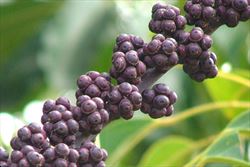
close-up of purple mature fruit (Photo: Sheldon Navie)
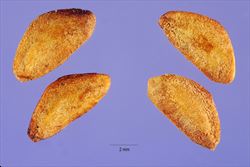
close-up of seeds (Photo: Steve Hurst at USDA PLANTS Database)
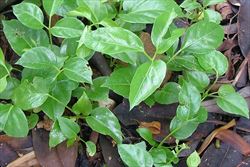
seedlings (Photo: Sheldon Navie)
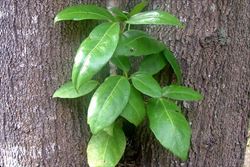
young plant growing in the fork of a tree (Photo: Sheldon Navie)
Scientific Name
Schefflera actinophylla (Endl.) Harms
Synonyms
Brassaia actinophylla Endl.
Family
Araliaceae
Common Names
Australian ivy palm, Australian umbrella tree, brassaia, ivy palm, lipstick palm, octopus tree, Queensland umbrella tree, schefflera, umbrella plant, umbrella tree
Origin
Native to northern Australia (i.e. the coastal districts of northern and central Queensland and the northern parts of the Northern Territory) and New Guinea.
Cultivation
Umbrella tree (Schefflera actinophylla) has been widely grown throughout the country as a garden plant and street tree (i.e. ornamental).
Naturalised Distribution
This species is becoming widely naturalised beyond its native range in eastern Australia (i.e. in south-eastern Queensland and the coastal districts of northern New South Wales). Also naturalised on Christmas Island and Lord Howe Island, and possibly naturalised on Norfolk Island and in south-western Western Australia.
Naturalised overseas in south-eastern USA (i.e. Florida), the Caribbean (i.e. Puerto Rico and the Virgin Islands) and on some Pacific islands (e.g. Fiji, Palau, French Polynesia and Hawaii).
Habitat
A weed of closed forests, rainforests, open woodlands, waterways (i.e. riparian areas) and coastal environs in these areas. This plant from northern areas has been widely cultivated in gardens. It is shade tolerant and invades disturbed or undisturbed forests and coastal bushland.
Habit
A fast-growing multi-stemmed tree usually growing 6-10 m tall, but occasioanlly reaching 20 m or more in height. Seedlings may germinate in the crotches of large trees, and in this case the plant will grow as an epiphyte until its roots reach the ground.
Distinguishing Features
- a multi-stemmed tree growing up to 10 m tall that occasionally grows as an epiphyte.
- its very large compound leaves are umbrella-like, with several glossy leaflets radiating from the same point.
- its small red flowers are borne in very large branched flower clusters at the top of the plant.
- its small fruit (6-12 mm across) turn dark red or dark purple as they mature.
Stems and Leaves
The thick branches are marked by conspicuous leaf-scars when they are young. They are dark green in colour, and covered with whitish spots (i.e lenticels). The bark older trunks in greyish or greyish-brown in colour and relatively smooth.
The once-compound leaves are very large, with several leaflets (7-16) radiating from the same point (i.e. they are palmately compound). The main leaf stalk (i.e. petiole) is robust and 15-60 cm long, while each of the leaflets is borne on a smaller stalk (i.e. petiolule) 2.5-8 cm long. Each of the glossy green leaflets is oblong to narrowly-oblong in shape (8-30 cm long and 4-8 cm wide) with pointed tips (i.e. acute apices). They are hairless (i.e. glabrous) and usually have entire margins, however seedling leaves may be slightly toothed towards their tips.
Flowers and Fruit
The flowers are borne in large branched clusters at the top of the plant (i.e. in terminal panicles). Each flower cluster has several branches up to 80 cm long that radiate outward from a central point. The small bright red flowers are grouped together in small clusters (1-2 cm across) along these flowering branches. Each flower usually has 12 petals (occasionally as few as 7 or as many as 18) that are pink to red in colour and only 3-5 mm long, while its sepals are reduced to a tiny rim about 1 mm long. The flowers have the same number of stamens as petals. Flowering occurs mostly during spring and summer.
The small fruit (6-12 mm across) turn dark red or dark purple in colour as they mature. They resemble berries bur have a hard centre (i.e. they are drupes).
Reproduction and Dispersal
This species reproduces by seed, which are mainly dispersed by birds and other animals that eat its fruit.
Environmental Impact
Umbrella tree (Schefflera actinophylla) is regarded as an environmental weed in south-eastern Queensland, New South Wales, and on Christmas Island.
It is also very invasive in other parts of the world (i.e. in Florida, Hawaii and on several islands in the south Pacific).
Other Impacts
The roots of this species are somewhat invasive. They can block plumbing joints and pipes as well as damaging footpaths and building foundations.
Legislation
Not declared or considered noxious by any state government authorities.
Similar Species
Umbrella tree (Schefflera actinophylla) is relatively similar to dwarf umbrella tree (Schefflera arboricola). These two species can be differentiated from each other by the follwong differences:
- umbrella tree (Schefflera actinophylla) is a relatively large tree usually growing 6-10 m tall. Its leaves are borne on robust stalks (i.e. petioles) 15-60 cm long and its leaflets are relatively large (8-30 cm long). Its pinkish-red to red flowers are borne in massive clusters with branches up to 80 cm long.
- dwarf umbrella tree (Schefflera arboricola) is a shrub or relatively small tree usually growing 3-4 m tall. Its leaves are borne on smaller stalks (i.e. petioles) 15-60 cm long and its leaflets are relatively large (4-15 cm long). Its greenish-yellow flowers are borne in massive clusters with branches up to 30 cm long.

